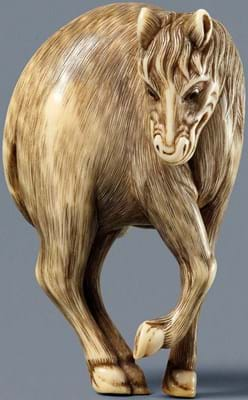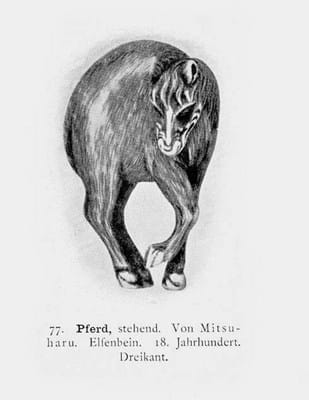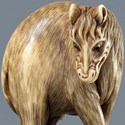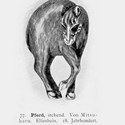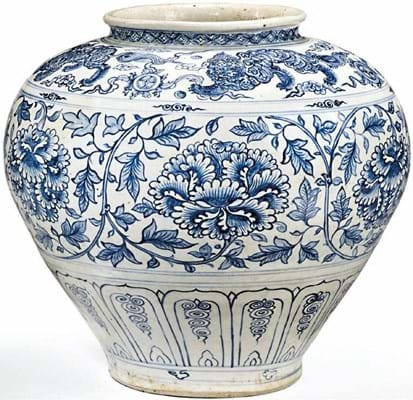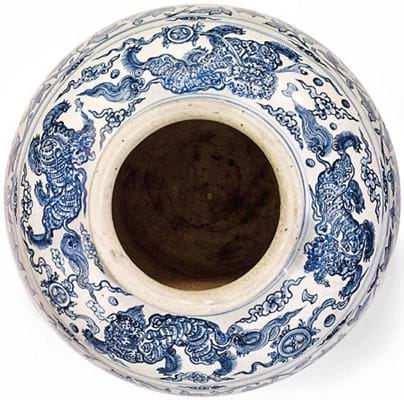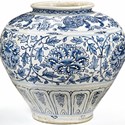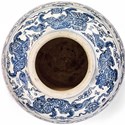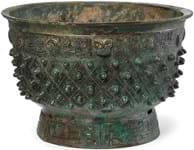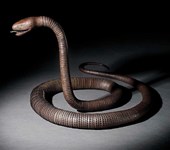The Exceptional Sale at Christie’s New York (25/20% buyer’s premium) on October 14 included what textiles consultant Elisabeth Parker called “the best example of Chinese carpet-making to be offered at auction in memory” (pictured top).
Measuring over 32ft 5in x 23ft 5in (9.88 x 7.14m), it is the largest Ming wool carpet outside of China, and one of only three floral surviving from the early 17th century Transitional period. Louis Comfort Tiffany lived with it for 30 years at his Long Island home, Laurelton Hall.
Wanli (1573-1619) carpets woven in Beijing have a distinctive weave with a thick pile knotted on silk warps while those made in the western region of Ningxia during the later Kangxi (1661-1722) era are thinner, with a looser weave.
This carpet falls somewhere in between – thicker than the Ningxia type, but thinner than the Wanli examples – and it is woven on a cotton foundation.
Its creation would have required a vast loom the same width as the carpet. “The weavers would have been shoulder to shoulder weaving and creating tension at the same time as they built up the design from the bottom to the top,” Parker says. “The pile of the carpet is still really thick — and in near original condition. The ground is now a beautiful beige, but would have once been red.”
The Tiffany Palace carpet, as it has come to be known, was purchased by Tiffany for $8000 in 1916. He re-sized it for his painting gallery, and repurposed the fragments as hallway runners, although it has since been restored.
Resold in three separate lots in 1946, all were bought by dealer and collector of classical Chinese carpets Frank Michaelian. He owned it for close to 40 years before it was bought by the media mogul Andrew Jerrold Perenchio (1930-2017) from The Textile Gallery, London.
Estimated at up to $1.2m at Christie’s, it sold at $1.4m (£1.1m).
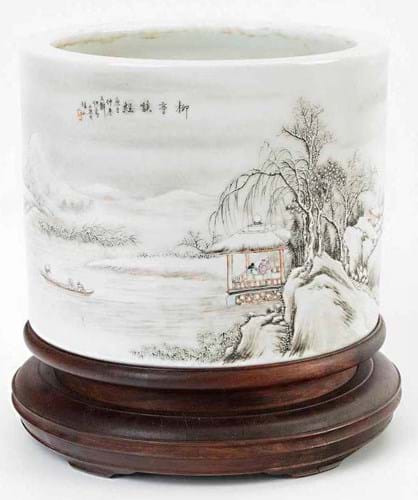
The sale at Schuler in Zurich on March 23-27 included this 20th century Chinese porcelain brush pot on a wooden stand, sold for SFr18,000 (£14,500).
The sale at Schuler in Zurich on March 23-27 included this 6in (15cm) high 20th century Chinese porcelain brush pot on a wooden stand. It is delicately painted to the cylindrical body in famille rose palette with a winter landscape and a lakeside pavilion.
As well as an inscription below the rim, the piece has an iron red mark reading Xuren Zhushan to the base.
The mark relates to He Xuren (1882-1940), a member of the Friends of Zhushan group of Republican-era porcelain painters.
A specialist in winter landscape painting, his work was frequently copied both during and after his lifetime. He used this mark c.1930-40.
The brush pot had a provenance to a Swiss private collection from 1975. It easily outstripped its SFr800-1200 estimate to take SFr18,000 (£14,500).
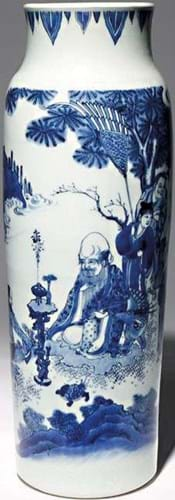
The sale of Chinese Paintings and Works of Art held by Woolley & Wallis in Salisbury on July 1 included this Transitional blue and white ‘sleeve’ vase, sold at £46,000.
The sale of Chinese Paintings and Works of Art held by Woolley & Wallis (25% buyer’s premium) in Salisbury on July 1 included a fine example of the Transitional blue and white ‘sleeve’ vase.
Standing a typical 18in (45cm) high, it was painted with Shoulao, the god of longevity, sitting with a deer as he watches a dance performance in a rocky mountain setting. An incense burner emits smoke which rises in the shape of a shou character – reinforcing the propitious blessings of long life.
The vase, from a British private collection, had been purchased for £15,000 at Christie’s in 2005 when it was dated c.1660. More probably the object was made in the final years of Chongzhen, the 17th and last emperor of the Ming who committed suicide as his capital city fell on April 25, 1644.
It was estimated this time at a very accessible £6000-8000 but took £46,000 (close to £60,000 with fees) from the European trade.
This is among the strongest auction prices for a piece of this type, although punchy sums were seen for a group of sleeve vases offered by Sotheby’s in May 2018 as part of an Italian collection.
On June 27 in Cologne, Lempertz (25% buyer’s premium) offered 200 netsuke consigned by the great-granddaughters of the legendary collector Albert Brockhaus (1855-1921).
Brockhaus, member of a famous publishing family in Leipzig, started acquiring netsuke in 1877. He recorded each piece on an index card, with information on the artist, the material, provenance, date of purchase and often a drawing of the object itself.
This card index was the base for Brockhaus’s seminal publication Netsuke from 1905 and expanded in 1909, which was the first western work on the subject.
Brockhaus was a voracious collector. At the 1913 sale of the British collector Walter L Behrens he bought 383 of the netsuke on offer.
After his death in 1921, the collection remained in Leipzig until the end of the Second World War, when it was transferred to West Germany and stayed in the hands of his descendants.
Since 1980, when Christie’s held a specialist sale in London, parts of the collection have come under the hammer.
The top price of the day was reserved for a mid-18th century ivory carving of a horse by Kyoto master Mitsuharu with the kudos of being illustrated in Brockhaus’ book (also shown above).
It sold to a German collector for €80,000 (£71,430).
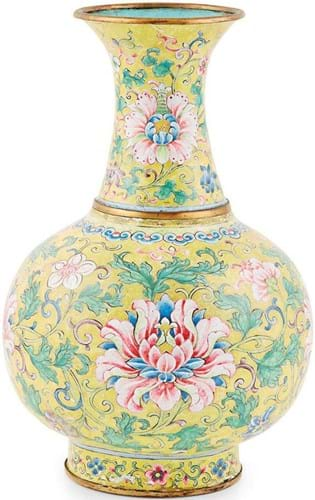
This Qianlong mark and period lotus vase from a Scottish country house sold for £36,000 at Lyon & Turnbull on May 13.
This Beijing enamel vase from a Scottish country house topped the Asian art sale held by Lyon & Turnbull (25% buyer’s premium) on May 13.
The £36,000 Qianlong (1736-95) mark and period lotus vase was one of 14 lots consigned from Balcarres House in Fife, home to the Lindsay family and the Earls of Crawford and Balcarres since 1595.
Decorated with a delicate floral design against a vibrant yellow ground, the 11in (27cm) vase is of a type made in the third quarter of the 18th century at the Imperial Workshops in the Forbidden City.
At Balcarres for several generations (it appeared in a number of inventories), it was probably among the collection of Chinese literature and works of art amassed by the 25th Earl (1812-80) and his son the 26th Earl (1847-1913) and now distributed among several British institutions.
It was not in perfect condition. Holes to either side of the neck of the vase suggest it once had a pair of bronze dragon-shaped handles, similar to those that adorn two pairs of enamel vases of this type in the collection of the National Palace Museum, Taipei.
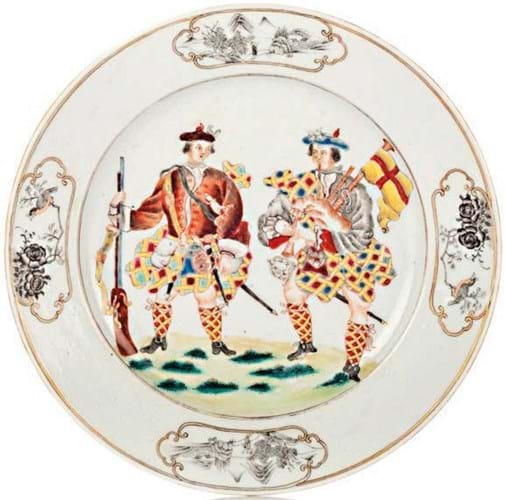
Famille rose porcelain design produced in China for export to Europe, a so-called ‘Scotsmen’ or ‘Highlander’ plate - R380,000 (£20,000) at Stephan Welz in Johannesburg on February 25-26.
Among the most recognisable of all the famille rose porcelain designs produced in China for export to Europe are the so-called ‘Scotsmen’ or ‘Highlander’ plates.
The subjects are thought to be two members of the Black Watch regiment that took part in a short-lived mutiny in Flanders in March 1743. Rifleman Shaw was among those shot at the Tower on July 18, 1743. Piper Macdonnel was sent to Georgia as a convict. The scene of the two Jacobite ‘martyrs’ is taken from 1743 engravings by George Bickham.
Highlander plates feature in a number of major Chinese export and Jacobite themed collections. The example pictured here, with a chip to the foot and some wear to the enamel, came up for sale at South Africa auction house Stephan Welz in Johannesburg on February 25-26 with a very appealing estimate of R25,000-35,000.
In fact it made something closer to other examples from the series sold in recent years when it was hammered at R380,000 (£20,000).
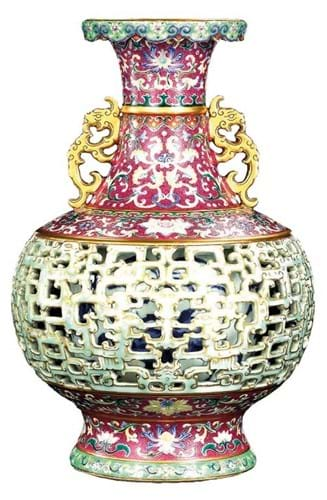
Sotheby’s July Hong Kong series included this Qianlong yangcai porcelain recently found in a Dutch country house, sold for HK$60m (£6m).
Sotheby’s July Hong Kong series included this ‘lost masterpiece’ of Qianlong yangcai porcelain recently found in a Dutch country house.
The ‘Harry Garner reticulated vase’ was rediscovered by Amsterdam-based art consultant Johan Bosch van Rosenthal. It previously belonged to two important collectors: Sir Harry M Garner (1891-1977) and Henry M Knight (1903-70). It had sold in 1954 for £44 and in 1954 for £80.
The vase fits the description of a piece praised as a masterwork in 1742 that was displayed in the Qianqinggong (Palace of Celestial Purity).
It belongs to a small group of pierced, double-walled vases created under the stewardship of the eminent kiln supervisor Tang Ying (1682-1756) that include the famous ‘Bainbridge’ vase and its pair sold by Sotheby’s for HK$149m (£14.6m) in 2018. Offered for sale on July 11 with hopes of HK$70m-90m, it fell a little short, selling to a single bid at HK$60m (£6m).
Two lost folios from the Yongle Dadian, the Ming dynasty encyclopaedia that has assumed national treasure status in China, surfaced for sale in Paris on July 7.
Estimated at €5000-7000, they sold for a massive €6.4m (£5.82m), or €8.13m once the 27% buyer’s premium was added.

Two lost folios from the Yongle Dadian, the Ming dynasty encyclopaedia that has assumed national treasure status in China, surfaced for sale at Beaussant Lefèvre in Paris on July 7 and sold for €6.4m (£5.82m).
Completed at the behest of the third Ming emperor, the Yongle Dadian (or Great Canon of Yongle) remained the largest encyclopedia in the world until the growth of Wikipedia in 2007.
Gathering knowledge from 8000 historic texts, some 2169 scholars worked on the project that by 1408 counted 22,877 juan (chapters) arranged across 11,095 yellow silk-bound volumes. The handwritten text assumed a novel ordering system that arranged the contents by phonics rather than by subject matter.
Today the contents of fewer than 400 volumes of the Dadian (around 3%) are known. The original 15th century manuscript did not survive the fall of the Ming while a copy commissioned by the Jiajing emperor between 1562-67 was largely burned or looted during the Second Opium War and the Boxer Rebellion.
The two volumes offered for sale at Beaussant Lefèvre’s Art of Asia sale on July 7 in the Drouot auction centre came for sale without a published provenance – although it is understood they had been a gift to the vendor’s ancestor, who worked in China in the 19th century.
They were numbered 2268-2269 (chapters dedicated to the geography of the lakes of China) and 7391-7392 (describing funeral rites). One of the 24 volumes in the British Library collection (chapters 7389-7390) immediately proceeds the latter.
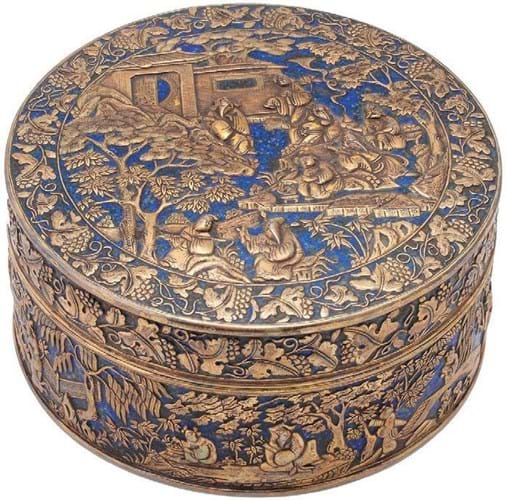
This 19th century Chinese export silver gilt and enamelled box sold for £14,000 at Dreweatts in Newbury on June 17 was almost certainly made for the Siamese market.
This 19th century Chinese export silver gilt and enamelled box, sold via thesaleroom.com for £14,000 at Dreweatts in Newbury on June 17, was almost certainly made for the Thai market.
Dated to c.1840-75, it depicts the auspicious scene of the Eight Taoist Immortals gathering in a garden against a lapis blue ‘shaolan’ ground. It carries a wen yin (cash silver) mark and another for the workshop of the Canton silversmith and retailer Hui Yuan which specialised in silver for the Siam trade.
A layer of copper sheet adding rigidity to the base – a common feature in Siamese silver that was adopted by Chinese silversmiths creating items for export.
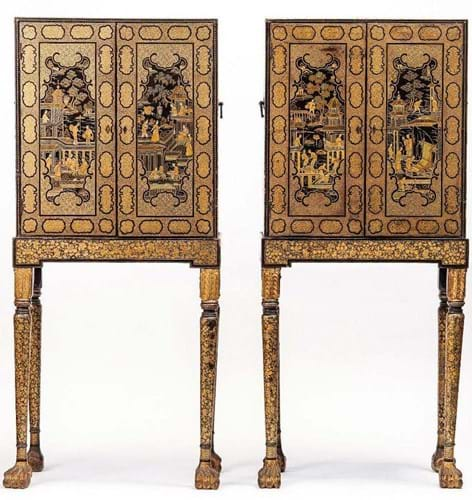
A pair of Chinese export black lacquer chinoiserie decorated cabinets on stands sold at Bellmans on August 11 for £32,500.
A pair of Chinese export black lacquer chinoiserie decorated cabinets on stands came for sale at Bellmans (22% buyer’s premium) in Wisborough Green, West Sussex, on August 11 with a blue-chip provenance.
On the market for the first time, they had been acquired prior to 1830 by Captain Richard Alsager (1781-1841) of the British East India Company and had then come by descent.
Textbook productions of the early 19th century that combine a popular Western form with sumptuous lacquer decoration, they sold for £32,500 (estimate £5000-10,000).
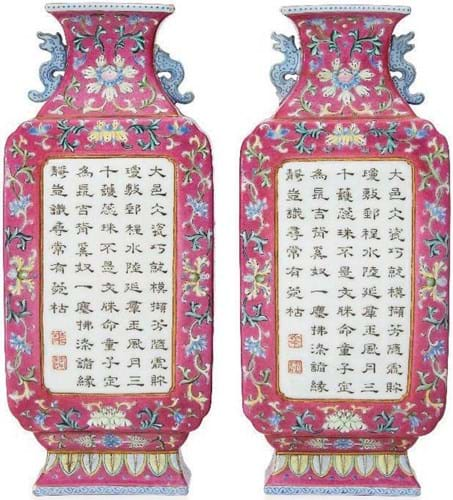
This pair of imperially inscribed Qianlong mark and period famille rose wall vases set a house record for Asian art at Roseberys on July 28 at £260,000.
This pair of imperially inscribed Qianlong (1735-96) mark and period famille rose wall vases set a house record for Asian art at Roseberys on July 28. Estimated at £20,000- 30,000, they sold for £260,000 (£324,500 including 25% buyer’s premium).
According to the archives of the imperial workshops, it was in 1742 that the art-obsessed emperor Qianlong instructed Tang Ying (1682-1756), head of the Jingdezhen imperial kilns, to produce porcelains inscribed with his poems.
The same year the first wall pockets were made following a request for a vase suitable for displaying fragrant flowers in a sedan chair. They became one of the emperor’s favourite forms and one that developed across his long reign.
Of the 320 Qianlong wall vases recorded in the collection of the Palace Museum in Beijing, 138 are inscribed with poems by the emperor.
This 8in (20cm) pair with a ruby ground feature The Hanging Bottle, a verse dated to 1758 in which the emperor expresses his delight in seeing a wall vase filled with flowers hanging inside his sedan chair on the way to a hunting trip. The two iron-red seal marks read Qianlong chen han (‘the Qianlong Emperor’s own mark’).
They came from a private west London collection and had been inherited around 1950. Condition issues included broken and rebuilt dragon handles (with small losses) and some chipping to two corners.
Christie’s claimed a new record for Vietnamese ceramics when a large 15th century blue and white storage jar sold for a surprise €380,000 (£339,300) in Paris on June 23. It came for sale from a Dutch collection with an estimate of €15,000-20,000.
It was during the Chinese occupation from 1407-28 that blue-and-white technology was first introduced to Vietnam. However, in addition to a noticeably heavier body (these are stonewares rather than porcelain), both brushwork and decorative motifs help differentiate early Vietnamese porcelain from its Chinese counterparts.
This 13in (33cm) high jar shares the same peony scrolls and buddhist lions decoration as another once owned by John D Rockefeller and now in the collection of the Asia Society.
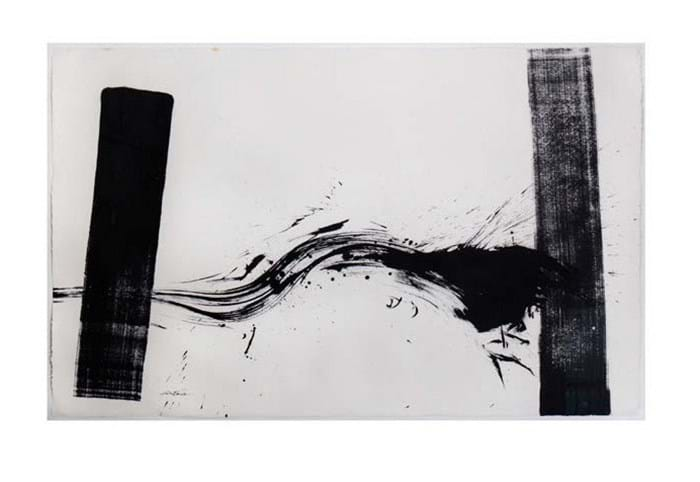
Civilization Landscape Series 0017, a 2012 painting by Qin Feng - £30,000 at Chiswick Auctions on September 29.
The single-owner collection of Chinese contemporary ink paintings offered by Chiswick Auctions (25% buyer’s premium) on September 29 was thought to be the first of its type in London.
The 92 works of the Nanyue Pavilion Collection, many of them deeply rooted in the tradition of classical Chinese painting, had been acquired over 30 years and were sourced through dealers, auctions, and acquisitions directly from artists.
Leading the sale was Civilization Landscape Series 0017, a 2012 painting by Qin Feng (b.1961) acquired from the Michael Goedhuis Gallery as part of the exhibition Qin Feng: Black Ink in Flight in May 2013.
Measuring 4ft 2in x 6ft 8in (1.25 x 2m) and estimated at £18,000-22,000, it sold at £30,000. The price exceeds the 2018 price for a work from the same series sold in Christie’s Hong Kong in November 18 which made HKD HK$260,000 (£26,000).



